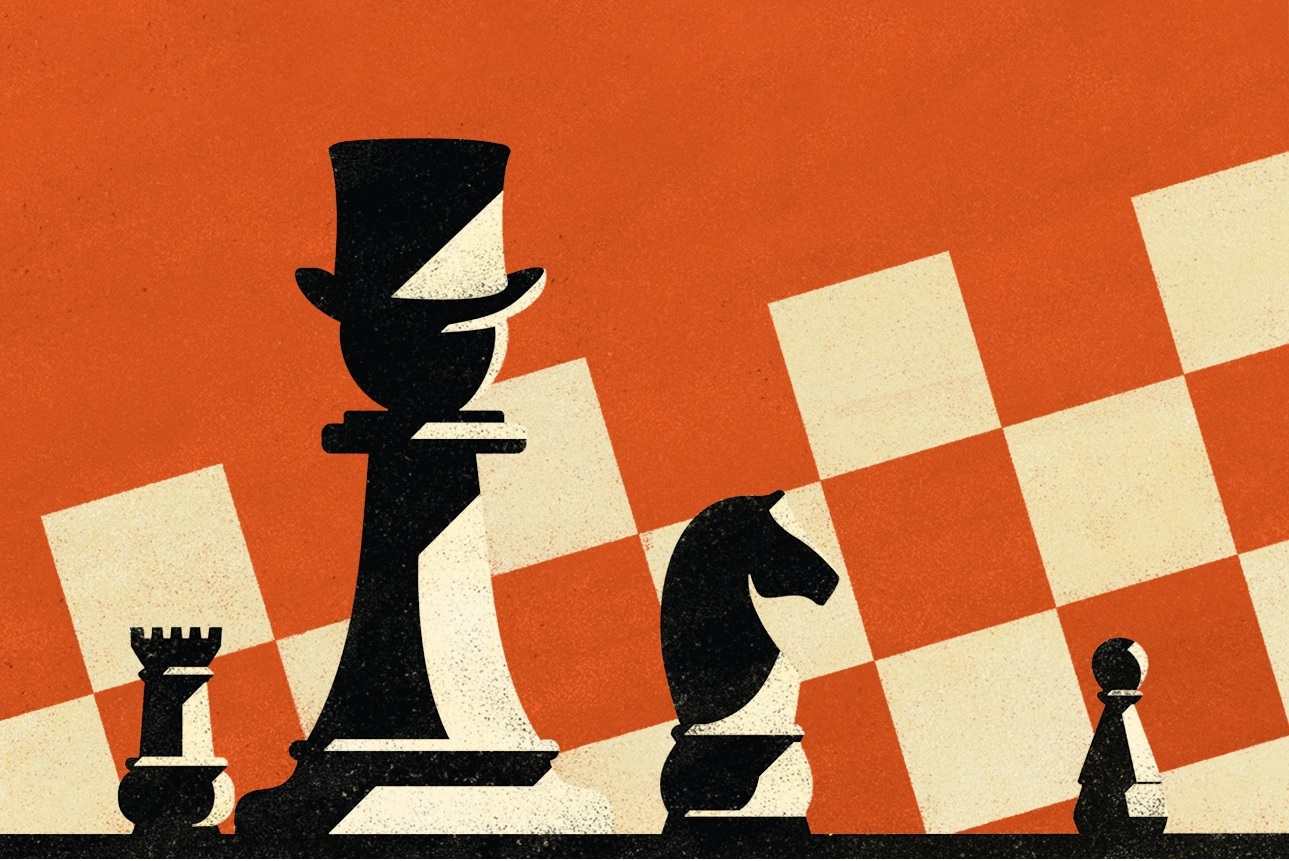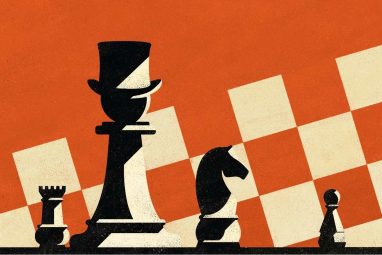Using Black Hat Workshops to Understand Your Competitors
How companies use competitive insight exercises to craft a strategic plan that anticipates rivals’ moves.
Topics

If you’ve ever played chess against a grandmaster, you were likely frustrated by their ability to block or counter all your planned moves. That’s what it can feel like when making strategic business moves against a competitor: No matter how brilliant our ideas, by the time we execute them, the competition has beaten us to the punch or is positioned to pounce from the back row with its queen, throttle our strategy, and checkmate.
How do we arrive at a better understanding of our competitors’ capabilities, plans, and thought processes? You can’t call up the CEOs of your competitors and ask for that information. But conducting a competitive insight workshop is an effective way to model how your competitors might behave in a particular scenario, and it’s a crucial method to avoid walking into traps ahead of launching any strategic initiatives.
A competitive insight workshop allows you to practice choices in a risk-free environment. You can run the exercise for multiple different markets, or multiple different go-to-market strategies, to home in on the “right” way to enter. Practice may not make perfect, but it’s a lot better than not practicing at all. That said, competitive insight exercises should not be used for every decision you make; they would lose their impact as a decision-making tool. Be selective about when and how you apply them.
A competitive insight exercise is a simulation, so make it as close to the real world as possible. Force your team to confront choices and situations they’re likely to face in the real world, not in some hypothetical construct.
My book Inside the Competitor’s Mindset contains guides to multiple types of competitive insight workshops. Here, I’ll focus on black hat exercises, where participants role-play a single competitor’s possible responses to one of your organization’s initiatives.
Imagine Competitors’ Reactions to Strategic Moves
As a competitive insight exercise, a black hat session helps you understand what it’s like to wear a competitor’s hat. What’s it like to view the world from its perspective?
A black hat exercise is focused on a particular strategic situation you’re facing — such as your plan to introduce a new product to the market, the potential entry of a competitor, or a change in government regulations. In its simplest form, a black hat session focuses on role-playing one competitor to analyze how it would approach that circumstance.
In the black hat workshop, the competitor will be role-played to simulate how it might react. Will it be aggressive? What levers will it pull? Will it even be capable of responding to the situation? You can also include other competitors and your own organization as players in the exercise and have them address specific questions — for example, “What could our role-play team do to make it more difficult for competitor X to be successful if it were to enter South America? And can we deter its entry in the first place?”
There are three steps to conducting a competitive insight workshop, regardless of the specific form: First, define the parameters of the exercise; second, build the material used in the workshop; and third, run the workshop. Let’s look at each of these in detail as they apply to a black hat exercise.
Define the parameters. Involve stakeholders at this stage, including workshop participants and others who will need to use the information generated. The latter group includes colleagues both upstream (such as senior managers) and downstream (such as front-line staff members). Clarify the scope of your planned exercise by working through the following questions:
- Who else wears a black hat besides our primary competitor? Do we want to role-play them in this session too?
- What types of tactics can the teams choose to execute?
- Where will we focus our discussion geographically? On which customer segments, and in which industry subsectors?
- When will the teams’ decisions be introduced to the market (or at least announced)?
- Why is the black hat competitor considering this strategic decision (in other words, what is its objective?), and how will other players view its potential move?
When designing other types of competitive insight workshops, I also ask how the outcome will be evaluated; that can be omitted here, however. Because a black hat exercise is more strategic than tactical, it doesn’t require a formal evaluation of the market outcomes. Shortly, I’ll explain how the session is run and how the insights regarding impact are generated.
Build the materials you need for the workshop. When you enter the room for the actual exercise, everything needs to be ready to go so that the participants can focus on the decisions they have to make and the insights
you want them to develop. What advance reading do the teams need to do in order to put themselves in the mindset of the roles they’ll be playing? Are there worksheets you want them to fill out to document their decisions? What models do you need to build to assess the market outcomes based on the teams’ decisions? What presentation materials must be created?
You should create the following materials for participants to help them participate in the workshop:
- An industry fact pack, so all of the participants are on the same page. These should include all relevant information about the market, such as market shares, average pricing, customer segments, demand growth, key government regulations, and technological changes.
- Role-playing fact packs, so the teams have a fact base to use when making their decisions. Participants role-playing the competitor teams will often assume that they should act either overly capable or completely incapable, but some might disagree on this point. For each team, assess the following: What is the competitor’s objective, and what has its historical performance been along key metrics? What are the key choices it has made in the past along the dimensions the team will examine in the workshop? What are the leadership profiles? Provide a fact base that aligns the team on the resources, assets, and capabilities available for the competitor role-players to use. Create a fact pack for other teams as well, including the team role-playing your organization (assuming there is one). There should be no cutting corners here and assuming that everyone on the team representing your company knows the relevant information about your organization. Putting the information in writing ensures that everyone is on the same page.
- A couple of scenarios around the question at hand to which the teams will react, such as two potential changes foreseen in the industry, a strategic move proposed by your own organization, or upcoming governmental changes to key regulations.
- A common template for all the teams to use that contains spaces to note which tactics they will use along each dimension (such as price, customer segment, product portfolio, R&D investment, or marketing spend).
- A scripted agenda to ensure that everything gets done on time. Key elements include an introduction, timing for each scenario (breakout and plenary discussions), breaks, and the debrief portion at the end of the session.
The first two items (industry and role-play fact packs) should ideally be shared with each participant a few days before the workshop so that they have time to read and begin to digest the information. Everyone receives the same industry fact pack (this is public information on the state of the market), but each participant gets only the role-play fact pack for the organization they are role-playing in the workshop.
The role-play fact packs should be considered private information that each team has available for itself, even though the material in them comes from publicly available sources. Assume that the others don’t have complete competitive insight assessments for all the players in the exercise. The teams role-playing the competitor organizations shouldn’t have that advantage.
Run the workshop to generate and capture competitive insights. Putting the planned scenario into play and watching the interactions of the role-play teams should surface examples of how competitors are likely to act and react when faced with certain situations.
A black hat exercise’s purpose should be established at the start of the day. Afterward, have participants break out into individual team rooms for 45 to 60 minutes to discuss how they would address the issues at hand in the context of the tactics/levers you’ve assigned (such as product portfolio, price, marketing spend, or partnerships).
If a team is role-playing a competitor contemplating a move — say, rumor has it that it’s planning to enter your geography or introduce a completely new type of product or service — then the team should debate how they would make that move if they ran the company. At the same time, in their own room, the team role-playing your own company should be discussing how they think the competitor will enter and debating whether, and how, to blunt that competitor’s move. Other teams might be role-playing another competitor’s actions, or those of complementors, platform partners, regulators, significant customers, or distributors.
After all of the teams have crafted their own strategic plans, they should regroup in the plenary session. Each of the teams will describe their plans, allowing the participants to debrief the implications for the market and their own organization. After all of the teams have spoken, they can question each other and probe assumptions and aspects that might have been omitted in the strategy descriptions. For example, let’s say your company’s team decides it wants to lower prices to preserve market share in the face of the competitor’s entry. When the competitor team announces its plan, it might not mention pricing, so the company role-play team should ask what the pricing would be.
What you do not want to discuss is the “why” behind each team’s choices. Don’t pull back the curtain to reveal the underlying objective of each team or the motivation driving the specifics of their plans. You will delve into this at the end of the workshop, but if you do it too early, latter workshop scenarios will not allow teams to wrestle with their choices.
After the teams have discussed the first set of plans, you can introduce a new scenario. For example, you might ask the teams to consider again a potential entry into the company’s core market, but this time under the assumption that the economy is entering a recession. The teams should break out into their rooms for 45 to 60 minutes to explore how they’d attack the market under the new constraints. They should subsequently gather again in a plenary session to announce their choices and discuss them.
After all of the planned scenarios have been analyzed, the teams should remain in a plenary session to discuss implications and debrief the entire session. Begin this phase by asking each team the following three questions:
- What was your team’s objective?
- What was your most interesting insight about playing your role today, either as it relates to that organization or to the industry overall?
- What remaining “unknowns” would you like clarified about your role or the industry in order to have better insight?
In other words, what were you trying to do, what did you learn by doing it, and what outstanding questions do you still have? This debrief at the end of the workshop should leave enough time for everyone to synthesize lessons learned. It should also offer a set of next steps for gathering additional information, exploring alternative strategic options, and disseminating the insights to others in the organization. Leave at least an hour at the end of the workshop for this summative debrief session, and be sure you debrief on the day of the workshop: Once participants leave, their recall of insights diminishes rapidly.
If you don’t allocate time during the workshop itself to discuss the insights as a team, then there won’t be any organizational learning. And if you don’t debrief the exercise on the same day, individuals may walk away with their own unique thoughts and conclusions. The entire group must leave the exercise with the same insights. You can always follow up a few days or weeks later to build upon those initial insights, but you want to have that shared starting point from the initial debrief. The whole point of the workshop is to generate organizational alignment on the competitor’s actions to prepare to address the potential threats.
Applying Insights in the Real World
The following is an example of a black hat exercise conducted for a client, a consumer electronics company. There were indications that a large multinational competitor might enter its geography, even though that competitor wasn’t currently selling the same product in the region. Some people at the client company thought the competitor wasn’t planning to enter (since it hadn’t yet) and that even if it did, they would be able to eat the competitor’s lunch and prevent any large market-share impact.
As the event unfolded, however, the client understood that despite its self-confidence, the multinational was very likely to enter the region. The statements the competitor had made about it were supported by actions the role-playing team took to set up the supply chain and distribution to support entry. The client team’s initial strategy proposal to counter the entrant in the workshop was overly confident. They were sure their company would prevent large market-share gains. However, in the plenary session where the first round of plans was announced, the client team realized its efforts would have no effect on the entrant. Actually, their actions might even open up entry routes for the competitor that might otherwise have been kept closed. At the end of the workshop, the client’s two main insights were:
- “The competitor will almost certainly enter and be a big threat when they do.”
- “Why can’t we start doing what the competitor team planned to do? Let’s talk with marketing and sales and operations to see if we can beat them to the punch.”




